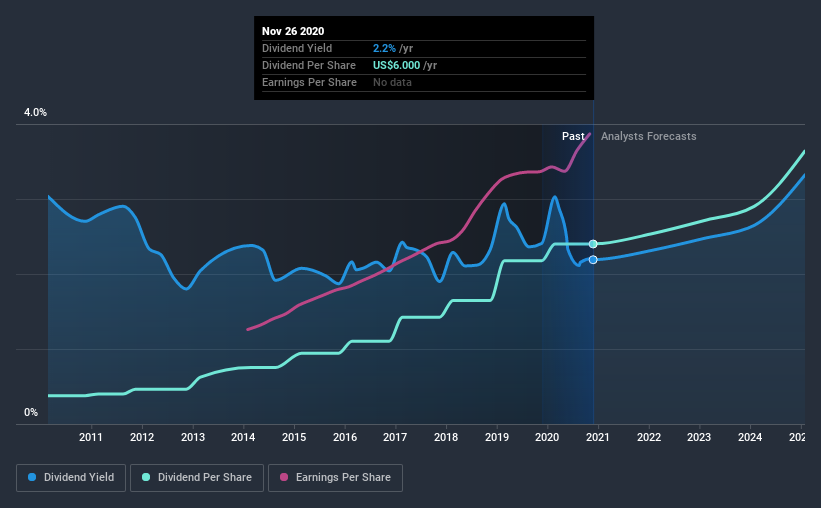Should You Buy The Home Depot, Inc. (NYSE:HD) For Its Upcoming Dividend?
Readers hoping to buy The Home Depot, Inc. (NYSE:HD) for its dividend will need to make their move shortly, as the stock is about to trade ex-dividend. You can purchase shares before the 2nd of December in order to receive the dividend, which the company will pay on the 17th of December.
Home Depot's next dividend payment will be US$1.50 per share, on the back of last year when the company paid a total of US$6.00 to shareholders. Based on the last year's worth of payments, Home Depot stock has a trailing yield of around 2.2% on the current share price of $273.96. Dividends are an important source of income to many shareholders, but the health of the business is crucial to maintaining those dividends. So we need to investigate whether Home Depot can afford its dividend, and if the dividend could grow.
View our latest analysis for Home Depot
Dividends are typically paid from company earnings. If a company pays more in dividends than it earned in profit, then the dividend could be unsustainable. Home Depot is paying out an acceptable 52% of its profit, a common payout level among most companies. Yet cash flows are even more important than profits for assessing a dividend, so we need to see if the company generated enough cash to pay its distribution. Thankfully its dividend payments took up just 35% of the free cash flow it generated, which is a comfortable payout ratio.
It's positive to see that Home Depot's dividend is covered by both profits and cash flow, since this is generally a sign that the dividend is sustainable, and a lower payout ratio usually suggests a greater margin of safety before the dividend gets cut.
Click here to see the company's payout ratio, plus analyst estimates of its future dividends.
Have Earnings And Dividends Been Growing?
Businesses with strong growth prospects usually make the best dividend payers, because it's easier to grow dividends when earnings per share are improving. If earnings fall far enough, the company could be forced to cut its dividend. Fortunately for readers, Home Depot's earnings per share have been growing at 20% a year for the past five years. Home Depot is paying out a bit over half its earnings, which suggests the company is striking a balance between reinvesting in growth, and paying dividends. Given the quick rate of earnings per share growth and current level of payout, there may be a chance of further dividend increases in the future.
Many investors will assess a company's dividend performance by evaluating how much the dividend payments have changed over time. In the past 10 years, Home Depot has increased its dividend at approximately 20% a year on average. It's great to see earnings per share growing rapidly over several years, and dividends per share growing right along with it.
The Bottom Line
From a dividend perspective, should investors buy or avoid Home Depot? Home Depot's growing earnings per share and conservative payout ratios make for a decent combination. We also like that it paid out a lower percentage of its cash flow. Overall we think this is an attractive combination and worthy of further research.
While it's tempting to invest in Home Depot for the dividends alone, you should always be mindful of the risks involved. Every company has risks, and we've spotted 2 warning signs for Home Depot you should know about.
We wouldn't recommend just buying the first dividend stock you see, though. Here's a list of interesting dividend stocks with a greater than 2% yield and an upcoming dividend.
This article by Simply Wall St is general in nature. It does not constitute a recommendation to buy or sell any stock, and does not take account of your objectives, or your financial situation. We aim to bring you long-term focused analysis driven by fundamental data. Note that our analysis may not factor in the latest price-sensitive company announcements or qualitative material. Simply Wall St has no position in any stocks mentioned.
Have feedback on this article? Concerned about the content? Get in touch with us directly. Alternatively, email editorial-team@simplywallst.com.

 Yahoo Finance
Yahoo Finance 
